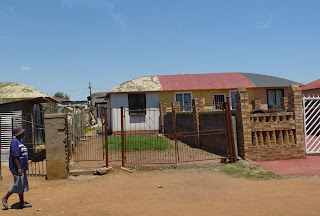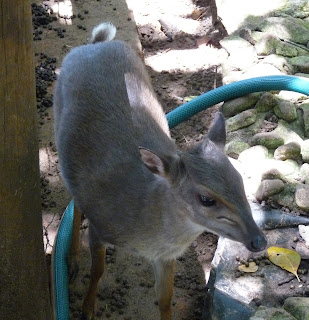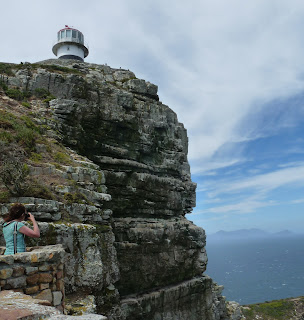Diane and I started the 2013 New Year
by attending a dinner with a group of Democratic friends at the home of H &
N. They were an interesting couple who spent most of their working years in
various foreign countries, H working for the WHO (World Health Organization)
and N working for USAID (United States Agency for International
Development). They lived on a farm
outside Columbia, and their house contained art objects and furniture they
collected while working in different countries.
Diane took delivery of her Apple Mac. I helped her choose a large monitor and set
it all up in her office, moving her PC to my office. I accompanied her to a class on Mac Basics. The instructor was so bad, I couldn’t even
follow him. He was teaching shortcuts to
new learners who didn’t know the long way in the first place. I knew Diane was in trouble, but she still
didn’t believe me, saying “Apples are the most user-friendly computers in the
world.”
Otherwise, our lives were busy
attending plays at the Columbia Entertainment Company and Stephens College,
movies at Ragtag and the Metropolitan Opera Live in HD performances at the
Forum Theatre. I never liked opera
before. I didn’t know the characters and
plots and couldn’t follow the foreign languages in which they were sung. The subtitles made it all understandable and
interesting. The interviews before the
opera, during the set changes and intermission added so much to our knowledge
about what was required to stage an opera.
As far as politics was concerned, I was still serving as treasurer for
Muleskinners, and fundraisers for candidates were starting for the city
elections in April.
Diane and I joined Paul and his wife Robin
for the dinner we had jointly purchased at the home of Amy Chow. It was amazing! Her entire family helped out. There were several courses of delicious
Chinese food, and Diane got some tips on how to prepare some of the dishes.
Before long, it was late January and time to
go on Road Scholar’s South Africa Wildlife Safari and the Garden Route
with an extension to Victoria Falls and Chobe.
In preparation for this trip, I read Cry, the Beloved Country and
several of Wilbur Smith’s historical fiction books. It used to take two days to travel to
Johannesburg, requiring an overnight stay in Europe. Luckily for us, Delta had flights from
Columbia to Atlanta and from Atlanta directly to
Johannesburg. Only two flights to
get to our destination, even though the second one was the longest flight we
had yet taken, almost 16 hours in the air.
Our Johannesburg hotel was only a short distance from the airport. At dinner, we met our guide and found that we
were part of a group that was small enough that he would also serve as the
driver of a large van. He immigrated to
South Africa from England and was married to an Afrikaans-speaking woman, but
he never learned her language. She was
probably a descendant from the Dutch and Huguenot settlers of the 17th century.
We met the other members of our group at breakfast the next morning. Our guide gave us an overview of South Africa and apartheid as we set out to tour Soweto (Southwestern Township), including Chris Hani Baragwanath Hospital, its taxi rank, Freedom Square and the Hector Pieterson Memorial. On our drive through Soweto, we saw a large collection of lean-tos and shacks which housed an ever-growing population. There were the inevitable nicer sections for more prosperous blacks or officials. The hospital in Soweto is the largest in Africa and possibly the third largest in the world. More than two thousand patients check into the hospital's specialized clinics and out-patient departments daily. It surprised me to learn that TB (tuberculosis) is South Africa's leading cause of death. Many of those with TB also have AIDS (acquired immune deficiency syndrome) as a result of having been exposed to HIV (human immunodeficiency virus).
Soweto shacks
Nicer house in Soweto
Nearly 70% of all Soweto commuters use the
Baragwanath Transport Interchange and Traders Market interchange. It aims to link the Greater Soweto Area with
Johannesburg and beyond. Freedom Square
honored the anti-apartheid activists and the document they created called “The
Freedom Charter.” It became the backbone
of South Africa’s very liberal constitution.
We were particularly interested to learn that in May 1996, South Africa
became the first jurisdiction in the world to provide constitutional protection
to LGBT people by disallowing discrimination on race, gender, sexual
orientation and other grounds. The
Hector Peterson memorial was named after one of the first casualties, but
commemorated all of those who marched through Soweto and were shot at by police
on the 16th of June, 1976. That date has become Youth Day, a public
holiday in South Africa. The photograph
of a student carrying 12-year-old Hector Peterson in agony was published
worldwide and became the emblematic image of the Soweto uprisings.
Taxi rank outside the Baragwanath
Hospital
Monument to the Charter at Freedom
Square
Poster describing the school shooting
of Hector Pieterson
We made a stop at the Apartheid Museum
where the local guide gave an account of 20th century South Africa. He spoke about the political upheavals
beginning in the last century and the transition from a racist state to the
current era. We drove to another area. As we walked to a restaurant, we passed by
the residence of Desmond Tutu, the first black archbishop of South Africa, and
the Mandala house. Nelson Mandala is best
known for his role in ending apartheid and becoming South Africa's first Black
president. On the way back to our hotel,
we went through the very busy and modern business district of
Johannesburg. After this busy day, we
relaxed over dinner at our hotel while overlooking a lake and getting to know
the other members of our group.
Tutu House plaque
Mandala house
We ate breakfast early so we could
catch our flight to Port Elizabeth on the Indian Ocean. This is where we would start our journey on
the Garden Route that follows the southern coast of South Africa. The name comes from the lush and ecologically
diverse vegetation and the numerous estuaries and lakes along the coast. After arriving in Port Elizabeth, we boarded
our van and headed to Plettenberg Bay.
There we boarded a boat for an eco-marine cruise. The guide talked about the unique geology of
the area as well as the animal life including dolphins, sharks, whales, seals
and pelagic birds. We observed many fur seals along the rocky coast. Returning to shore, we continued west to
Knysna.
Eco-marine cruise boat passengers
Colony of fur seals
After a morning stroll along the
waterfront, we took a ferry across the Knysna Lagoon to the Featherbed Nature
Reserve. It is a unique 370-acre private
reserve, situated on the Western Cliffs of the Knysna Heads. A truck took us up to the overlook, while the
local expert discussed the unique ecology of the reserve. While at the overlook, we enjoyed magnificent
views of the coastline and estuary. In
the company of a Featherbed ranger, we then hiked down a treacherous path which
had many steps. We walked through the
forest, into the caves and along the spectacular lagoon coastline. We were told about the plants and animals at
this Reserve, one of South Africa's premier Natural Heritage Sites. We did see a Blue Duiker, one of Africa's
smallest antelope species, and a Black African Oyster Catcher.
Knysna Lagoon ferry
Knysna estuary
Featherbed path
Featherbed steps
View from path
Warning sign
Diane and I did not trespass
Flowers
Oyster catcher
Blue Duiker
In the afternoon, we went to the
Knysna Elephant Park. When it opened in
1994, it was the first facility in South Africa to house and care for orphaned
African elephants. These included
relocated animals, orphaned calves and elephants rescued when others in their
herd were being killed to reduce their population (culled). Some have become part of the resident herd,
others have moved onto other reserves and facilities in the Western and Eastern
Cape, depending on their personalities, bonds with other animals and welfare
needs. They are free to graze and wander
as they would in the wild, but there are trained handlers around. We saw the barns where they spent the nights
and were told about their eating habits.
Diane did not care to interact with an elephant, but I found these
gentle giants quite approachable. Those
of us who were interested were given a bucket of fruit and allowed to feed an
elephant of our choice. I chose a medium
sized elephant and, with a trainer nearby, placed a piece of fruit in the palm
of my hand and held it out for the elephant.
Mine picked it up with its trunk and put it in its mouth. We got so chummy that it would let me stand
next to it and pet its skin. It even
opened its mouth for me to touch its soft tongue. WOW, what an afternoon!
Elephant barn
Park land
Me and others feeding elephants
Me feeding baby elephant
Me stroking an elephant tongue
We next
drove through the Wilderness Lake area to Mossel Bay, the nominal end of the
Garden Route. Then we drove north of the coast through farmland with harvested
wheat fields and vineyards before dropping back south to the Grootbos Nature
Reserve. It is an award-winning nature
reserve and home to more than 740 different species of plants. A botanist led our group on a tour of the
property which is surrounded by indigenous shrubs, or Fynbos, and milkwood
forests. As well as having very hard
timber, the milkwood has considerable value in traditional medicine and attracts
birds, monkeys and other animals to its flowers and fruits. Before we left, we helped plant an indigenous
tree. The Grootbos Foundation also
operates the Green Futures Horticulture and Life Skills College admitting a
small number of native students each year to train in horticulture, eco-tourism
and hospitality management.
Botanist tour
Planting tree
Leaving the coastal plains, our van took us
up into the mountains and around the Theewaterskloof Dam. The name of the towns, Franschhoek (near
where we visited a winery) and Stellenbosch (where we spent the night)
indicated we were in the part of South Africa settled by the Dutch Boers. It was an area known for its wines and good
education.
The mountains
When we got to Cape Town the next morning,
we were supposed to go up Table Mountain, but we were disappointed to see that it
was shrouded in fog. It had the name
Table Mountain because of its flat top. However,
it was covered by clouds that form when a wind is directed up the mountain's
slopes into colder air. Then the
moisture condenses to form the so-called "table cloth" of cloud.
Table Mountain
Instead, we went on a walking tour through
Cape Town. We began in the Bo Kaap
community known for its colorful houses.
It is a traditionally multicultural neighborhood having a large Muslim
population. We passed the Castle of Good
Hope, a fort built in the 17th century on the shoreline of Table Bay that is now
landbound because of land reclamation. We
went on to the Company’s Garden, a historic park and heritage site. It was created in the 1650s by the region's
first European settlers to grow fresh produce for replenishing ships rounding
the Cape. Now it is a large public park
and botanical garden home to: a Rose Garden, Japanese Garden, Fish Pond and
Aviary. Desmond Tutu led numerous
marches and campaigns for the formal end of apartheid on the front steps of the
nearby St. George’s Cathedral.
Castle of Good Hope with moat
Company’s Garden with a surprising statue
of Cecil John Rhodes, a man whose policies were meant to push the black
population off their land
After lunch, our van drove us up to
Kirstenbosch Gardens in the foothills of Table Mountain. We went on a guided walk through one of the
greatest botanical gardens in the world and also a UNESCO World Heritage
Site. It was established in 1913 to
promote, conserve and display the rich and diverse flora of southern
Africa. We had unexpected sightings of a
weasel and Egyptian geese during our tour.
Fireball Lilly
Graskop Agapanthus
Me following our guide
Weasel
Geese
Even gorillas
Back down the hill, we checked into the
Protea Hotel Breakwater Lodge, the most interesting hotel in which I have ever
stayed. It was originally built as a
British prison in 1859 called Breakwater Prison. It also housed the University of Cape Town
Graduate School of Business. Directional
signs in the hotel had labels like “Blocks” and “Turrets.” Scattered about there were exhibits from the
time it was a prison.
Hotel Signage
I was excited that the next morning we
would visit the Cape of Good Hope, since we sailed near Cape Horn at the tip of
South America on our 2005 trip to Antarctica.
There was much to see at the Cape: wharfs, beaches and wildlife. Starting from the harbor near our hotel, we
headed to the opposite side of Table Mountain before heading down the Atlantic coast
with scenic views of beaches and cliffs.
When we reached the peninsula that stretches down to Cape, we left the
Atlantic and crossed over to the False Bay side of the Cape Peninsula. We stopped to see the statue of Just
Nuisance, a large Great Dane who, during WWII was the only dog ever to have
been officially enlisted in the Royal Navy.
Just Nuisance
At Boulders Beach we saw the African
Penguin with its distinctive pink patches of skin above the eyes and a black
facial mask. It was formerly called the
jackass penguin, due to the loud, donkey-like sound it makes. The next wildlife we saw was a troop of
baboons, two bird colonies and ostriches.
We finally reached the Cape of Good Hope, the confluence of the Indian
and Atlantic Ocean where our guide found a spot for us to enjoy our box
lunches. The Flying Dutchman Funicular
that traveled on railroad tracks took us up to the Old Lighthouse on Cape Point
for the spectacular views from on high.
It was a full, enjoyable day of history and nature.
African Penguins
Baboons
Ostrich
Looking towards parking area from inside
the funicular
View from Cape Point
The next day was a real counterpoint. Our van drove about 20 miles to Khayelitsha
township and stopped at a building labeled eKhaya eKasi which means “home in
the hood” in the Bantu language of the isiXhosa people. It was the location of “The heART of a Woman”
program in Cape Town and a community center. It was run and staffed by women living in the
township and served hundreds of local residents. One of the purposes of its arts and crafts
program was to train some of the women to make art objects to sell and support
the project. We saw the rooftop and
outdoor garden and kitchen. Then we
entered a big room with about 20 older women of the community sitting at
tables, many wearing elaborate hats.
After lunch, they stood as a group and sang us a song in their native
language as they didn’t speak English.
We reciprocated, singing the old reliable “You Are My Sunshine.”
Community center
Area being served as seen from rooftop of
center
Crafts for sale
Women serenading our group
In the afternoon, we took the ferry to
Robben Island. From the 1500s, the
island has been used for many different purposes, first serving as a stopping
point for passing ships in the 16th and early 17th centuries. Then, after early efforts at settlement, it
served as a penal colony, a leper colony, a place for those judged insane and
finally as South Africa’s maximum-security prison. Most inmates, including Nelson Mandela, were
black men incarcerated for political offenses. The last of these prisoners were
not released until 1991. The island
continued to serve as a medium-security prison for criminal offenders until
1996. In 1997 it was turned into a
museum and declared a national monument, and in 1999 it received designation as
a World Heritage Site. A man who
previously had been an inmate gave us a tour of the island and prison,
including the cell where Nelson Mandela lived and wrote. It was very touching.
Entrance to Robben Island
Our tour guide
Nelson Mandela cell
That evening, our small group ate dinner at
a Muslim restaurant in the Bo Kaap community, sitting outside on a balcony with
a view of Table Mountain. Before we left
the hotel the next morning, we had our final tour of the prison part of our
hotel where we saw the cells that were used for solitary confinement and a
treadmill. To break the spirit of
prisoners on arrival at the prison, or as punishment for difficult inmates,
warders used a treadmill, a giant version of the toy that pet hamsters play on.
The version built in 1890 for inmates was no toy. Prisoners had to keep a steady pace as they
walked up the stairs that were continually rotating. If they slowed down, the wooden planks could
lacerate or even smash their shins.
Our tour group at dinner
Gears that kept the stairs rotating up
Stairs the prisoners had to keep pace with
In the morning, we flew toward Kruger National Park for the safari part of our trip. Thus far I had learned about South Africa’s history, culture and beauty, and soon I would find out what it was like to be on safari.




















































